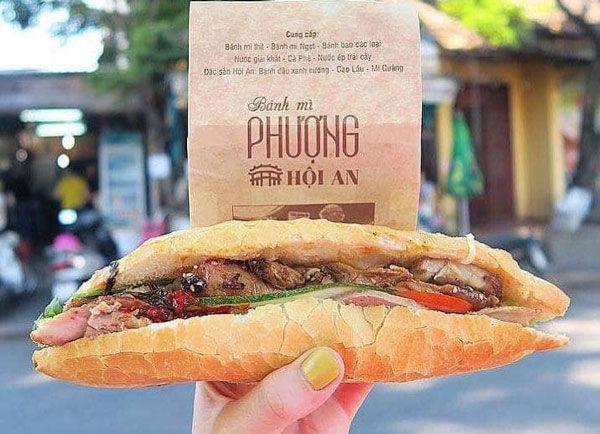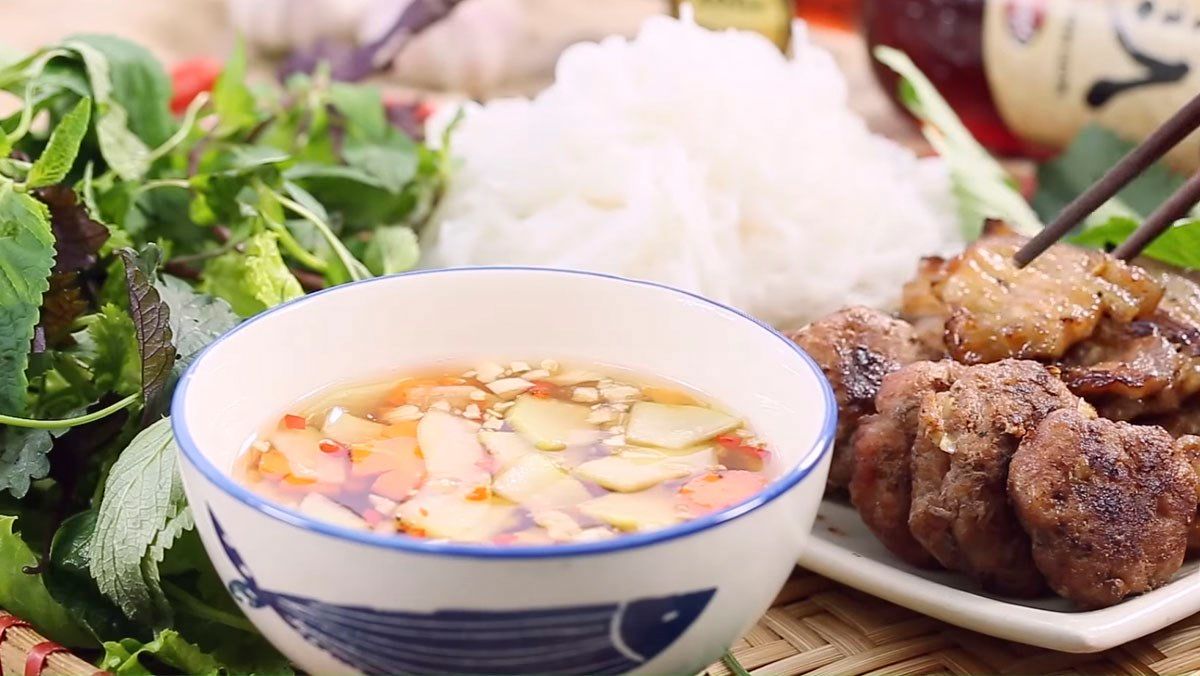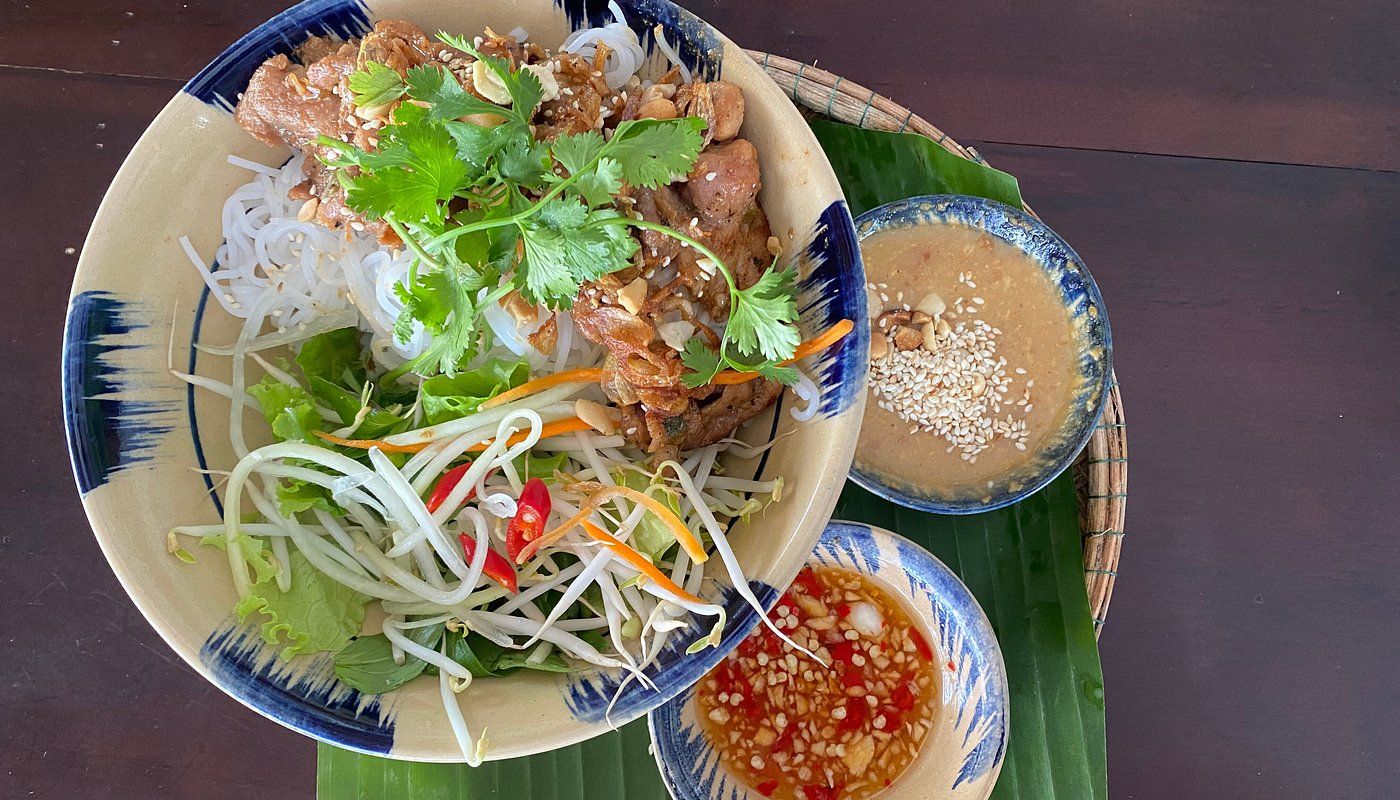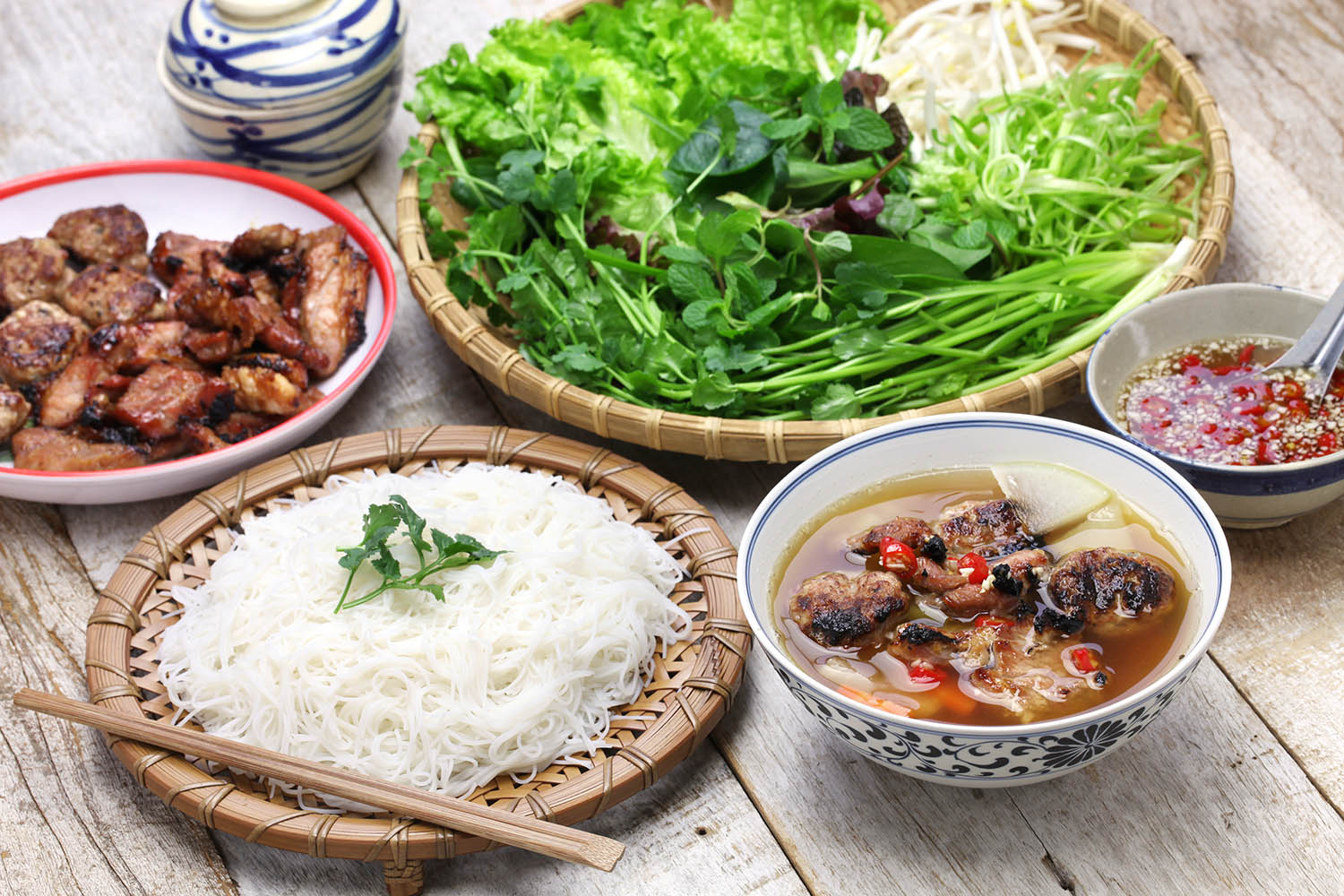Vietnamese food is famous worldwide for being fresh, healthy, and incredibly satisfying. The cuisine is defined by the use of local herbs, rice, vegetables, and protein sources like pork, chicken, beef, and seafood. Instead of relying heavily on oils or artificial seasonings, dishes are often lightly cooked to preserve both flavor and nutritional value. Each region – North, Central, and South – brings its own unique personality to the table, creating a food journey that’s both diverse and deeply rooted in regional traditions.
Top 20 Must-Try Vietnamese Dishes You Should Eat in Vietnam
Vietnamese cuisine is varied by flavors, variety and even ingredients as you travel across the country, all of them, from the textures, and traditions reflects the country’s deep connection to culture.
Across the S-shaped nation (Vietnam Map shaped like the Letter S), food is more than sustenance; it is culture, history, and a shared story passed down through generations. What sets Vietnamese food apart is not heavy seasoning or overly complex cooking techniques, but its respect for natural flavors. From fresh herbs to rich broths, most dishes aim to enhance the original taste of the ingredients themselves.
Whether you’re slurping noodles on a busy Hanoi street or biting into a crusty sandwich in Ho Chi Minh City, the simplicity and balance in Vietnamese cooking leave a lasting impression on every traveler’s palate.
- Check out Vietnam luxury tours
1. Phở – Vietnam’s Most Famous Noodle Soup
Phở is Vietnam’s most internationally recognized dish, and for good reason. It’s a comforting bowl of flat rice noodles in a clear, savory beef or chicken broth that’s been simmered for hours with bones, ginger, cinnamon, star anise, and cloves. The result is a fragrant, balanced soup topped with thin slices of beef or chicken, scallions, and herbs like Thai basil or cilantro.
Expect to pay around 30,000–50,000 VND per bowl. For a traditional Hanoi-style phở, try Phở Gia Truyền Bát Đàn in Hanoi. If you’re in Ho Chi Minh City, Phở Hòa Pasteur is a beloved Southern-style spot.
- Check out Vietnamese dishes for winter
2. Bánh mì – A Flavorful Sandwich
Bánh mì is the ultimate fusion food, a French baguette filled with Vietnamese-style meats like grilled pork, pate, cold cuts, pickled carrots, cucumber, coriander, and a touch of chili. The bread is light and crisp, and the fillings create a harmony of savory, sour, and spicy.
Each sandwich costs between 15,000–30,000 VND. Try Bánh Mì Huỳnh Hoa in Ho Chi Minh City for an indulgent, meat-heavy version, or Bánh Mì 25 in Hanoi for a more balanced, herb-forward taste.
- Check out Banh Mi Vietnam

3. Bún Chả – Grilled Pork with Noodles and Fresh Herbs
A Hanoi favorite, bún chả combines smoky grilled pork patties and thin slices of pork belly served in a sweet-sour dipping sauce with cold rice noodles and a generous basket of herbs. The pork is marinated in fish sauce, sugar, garlic, and shallots before grilling over charcoal.
Expect to spend about 40,000–60,000 VND. For an authentic experience, head to Bún Chả Hương Liên, famously visited by Obama and Anthony Bourdain.

4. Bún bò Huế – Spicy Beef Noodle Soup from Central Vietnam
Bún bò Huế is a robust, spicy noodle soup from the former imperial city of Huế. Its broth is beefy with hints of lemongrass and chili, often with thick round noodles, slices of beef shank, pork knuckle, and cubes of congealed blood.
A bowl costs around 35,000–60,000 VND. For a classic version, try Bún Bò Huế Mệ Kéo in Huế or Quán Bún Bò Gánh in Saigon.
5. Nem rán – Crispy Vietnamese Spring Rolls
Also known as chả giò in the south, nem rán are deep-fried rolls filled with minced pork, wood ear mushrooms, vermicelli, and vegetables wrapped in rice paper. They’re crunchy outside, savory inside, often dipped in a sweet fish sauce blend.
Prices range from 5,000–10,000 VND per roll. Try Nem Rán Ngọc Thạch in Hanoi for a home-style taste.
6. Gỏi cuốn – Freshly wrapped Rolls
Gỏi cuốn offers a lighter alternative with fresh rice paper rolls filled with shrimp, pork, lettuce, vermicelli, and herbs. They’re served cold with hoisin-peanut or fish sauce dip.
Usually priced at 10,000–20,000 VND per roll. A great place to try them is Wrap & Roll (a chain), or Gỏi Cuốn 359 Nguyễn Thái Bình in District 1, Saigon.
7. Bún đậu mắm tôm – Love It or Hate It
Not for the faint of heart, this Northern specialty includes rice noodles, fried tofu, pork belly, herbs, and fermented shrimp paste (mắm tôm). The bold dipping sauce is what makes this dish polarizing but beloved.
You’ll pay around 35,000–60,000 VND. Bún Đậu Mẹt in Hanoi or Bún Đậu Homemade in Saigon are good bets.
8. Bánh cuốn nóng – Steamed Rice Rolls
Bánh cuốn are silky rice flour sheets filled with minced pork and mushrooms, topped with fried shallots and served with dipping sauce and Vietnamese ham (chả lụa).
Expect to pay 25,000–40,000 VND. For a popular local spot, check out Bánh Cuốn Bà Hanh in Hanoi.
9. Xôi – Sticky Rice in Many colors
Xôi is glutinous rice served either savory or sweet. You’ll find it with mung bean paste, fried shallots, Chinese sausage, or even shredded chicken. It’s filling, fragrant, and great on the go.
Usually around 10,000–30,000 VND. Try Xôi Yến in Hanoi for classic savory versions.
10. Bánh Xèo – Crispy Sizzling Vietnamese Pancakes
Vietnamese food is famous worldwide for being fresh, healthy, and incredibly satisfying. The cuisine is defined by the use of local herbs, rice, vegetables, and protein sources like pork, chicken, beef, and seafood. Instead of relying heavily on oils or artificial seasonings, dishes are often lightly cooked to preserve both flavor and nutritional value. Each region – North, Central, and South – brings its own unique personality to the table, creating a food journey that’s both diverse and deeply rooted in regional traditions.
11. Chả mực Hạ Long – Fried Squid Paste
From Ha Long Bay, chả mực is a delicacy made from freshly caught squid, hand-pounded and fried until golden and chewy. Often served with sticky rice or noodles.
Costs about 50,000–70,000 VND. Best enjoyed at Chả Mực Hạ Long Bà Ngân or local Ha Long markets.
12. Bún bò trộn Nam Bộ – Southern Mixed Beef Noodles
This dry noodle dish features rice noodles, stir-fried beef, pickled carrots, cucumber, peanuts, and herbs, all tossed with a tangy fish sauce dressing.
You’ll pay around 35,000–50,000 VND. Head to Bún Bò Nam Bộ Bách Phương in Hanoi for a highly rated version.
13. Bún riêu – Crab and Tomato Noodle Soup
A lighter soup, bún riêu features a tangy tomato broth with crab paste, tofu, sometimes snails or blood cubes, topped with herbs. The taste is bright and coastal.
A bowl goes for 30,000–50,000 VND. Visit Bún Riêu Cua Hàng Bạc in Hanoi or Bún Riêu Gánh in Saigon.
14. Bún thang – Elegant Hanoi Noodle Soup
This sophisticated dish layers chicken, egg, Vietnamese ham, and shredded pork floss in a delicate clear broth over vermicelli noodles. Often flavored with a hint of shrimp paste.
Around 40,000–60,000 VND per bowl. Try Bún Thang Bà Đức in Hanoi Old Quarter.
15. Cơm tấm – Broken Rice with Grilled Pork
A southern staple, cơm tấm is broken rice topped with grilled pork chop, egg meatloaf, pickled vegetables, and fish sauce. It’s smoky, sweet, and satisfying.
Costs about 30,000–50,000 VND. Don’t miss Cơm Tấm Ba Ghiền in Saigon.
16. Bánh Chưng – Traditional Lunar New Year Sticky Rice Cake
A square-shaped sticky rice cake filled with mung beans and pork, wrapped in green dong leaves. It’s boiled for hours and eaten year-round, though especially during Tết (Lunar New Year).
Usually 30,000–70,000 VND depending on size. Find fresh versions at local markets before the New Year or specialty shops like Giò Chả Quốc Hương in Hanoi
17. Cơm hến – Clam Rice from Hue city
This dish layers tiny stir-fried clams, crunchy peanuts, rice crackers, herbs, and rice with a spoonful of clam broth. It’s textural, spicy, and deeply local.
You’ll spend about 25,000–35,000 VND. Visit Cơm Hến Hoa Đông in Huế for a traditional take.
18. Cháo quẩy – Rice Porridge with Fried Dough
Cháo is comforting rice porridge, often plain or with chicken or fish, served with crispy Chinese crullers (quẩy). It’s mild, warm, and ideal for breakfast or rainy days.
Usually 15,000–30,000 VND. Cháo Sườn Huyền Anh in Hanoi is a popular pick.
19. Nem nướng/Nem lụi – Grilled Pork Skewers
These central Vietnamese skewers are made of seasoned pork, grilled and served with rice paper, fresh greens, and thick dipping sauce. Nem lụi tends to be softer and rounder.
Expect 30,000–50,000 VND per set. Try Quán Hành Nem Lụi in Huế or Nem Nướng Nha Trang Đặng Văn Quyên in Nha Trang.
20. Nem chua Thanh Hoá – Fermented Pork Snack
Nem chua is a sweet-sour fermented pork roll with garlic and chili, typically wrapped in banana leaves. It’s chewy, tangy, and often eaten with beer.
Prices range from 5,000–10,000 VND each. The best come from Thanh Hóa, but you can also buy at Hanoi markets or specialty shops.
- Check out Hanoi beer street
Regional Differences in Vietnamese Cuisine: North, Central, and South
Did you know that a bowl of Phở tastes different in the North, Central, and South? This is true for almost every dish in Vietnam! Topography, climate, and historical influences from other countries shape each region’s cuisine by affecting the availability of key ingredients.
Northern Vietnamese Cuisine – Subtle Flavors and Tradition
In the North, especially around Hanoi and the Red River Delta, the cuisine is known for its elegance and restraint. Influenced heavily by ancient traditions and a cooler climate, Northern food uses less sugar and spices than other regions. Instead, it emphasizes clean, balanced flavors and seasonal ingredients. Dishes like phở, bún thang, and bánh cuốn rely on well-made broths and subtle seasoning rather than bold marinades.
In the North, cooks use soy sauce and vinegar more often than coconut milk or sugar, and they add herbs sparingly to avoid overpowering the dish. Chinese influence appears in many preparations, especially noodle dishes and stir-fries. Northern meals often include a variety of pickled vegetables (dưa góp) to add crunch and balance the flavors.
Central Vietnamese Cuisine – Spicy, Complex, and Imperial
Moving south to Central Vietnam, particularly in cities like Huế, Da Nang, and Hoi An, the cuisine becomes spicier and more colorful. Central Vietnamese food is famous for its bold, complex flavors, sour, spicy, salty, and umami often come together in a single dish.
This region is the birthplace of many imperial court dishes, as Huế was the seat of the Nguyen Dynasty. As a result, food here often looks more decorative and refined, with smaller portions that reflect a royal dining style. Dishes like bún bò Huế, mì Quảng, and bánh bèo are rich in taste, typically spiced with chili oil, fermented shrimp paste, and lemongrass.
Due to the harsher weather and terrain, Central Vietnamese people have traditionally preserved food more aggressively, through fermentation, salting, and drying, which also adds a depth of flavor to their cooking.
Vietnamese food is famous worldwide for being fresh, healthy, and incredibly satisfying. Local herbs, rice, vegetables, and proteins like pork, chicken, beef, and seafood define the cuisine. Cooks lightly prepare dishes to preserve both flavor and nutritional value, avoiding heavy oils and artificial seasonings. Each region – North, Central, and South – brings its own unique personality to the table, creating a food journey that’s both diverse and deeply rooted in regional traditions.

Southern Vietnamese Cuisine – Sweet, Abundant, and Herb-Filled
In Southern Vietnam, especially in Ho Chi Minh City and the Mekong Delta, the cuisine reflects the region’s tropical climate and fertile land. This is where dishes become sweeter, fresher, and more generous in portion and variety. Southern Vietnamese food bursts with vibrant, aromatic flavors thanks to generous use of coconut milk, palm sugar, herbs, and vegetables.
Staples like cơm tấm, hủ tiếu, and bánh xèo are often accompanied by multiple dipping sauces, pickled vegetables, and fresh greens. The South is home to a strong street food culture, where people often gather with friends and family to enjoy meals in casual, open-air settings.
Because of its history as a trading hub, Southern cuisine also bears the influence of Cambodian, Thai, Chinese, and even Indian flavors, evident in the use of curry, chili, and tropical fruits. The abundance of fresh seafood and tropical produce gives Southern dishes a bright, comforting, and crowd-pleasing character.
Final Thoughts: Discovering Vietnam Through Its Cuisine
Experiencing Vietnam through food is like watching a story unfold from chapter to chapter. In the North, you’ll taste the roots of tradition; in the Central region, the spice of resilience and elegance; and in the South, the openness and abundance of a warm, fertile land.
When you travel across the country, try the same dish in multiple regions to appreciate how local influences transform it. A bowl of phở in Hanoi might be subtle, with a clear broth and few herbs, while in Saigon it might arrive loaded with bean sprouts, basil, lime, and hoisin sauce. A plate of bánh xèo in Huế will be small and crispy, while in the South it’s large, coconut-infused, and packed with fillings.
So as you plan your culinary journey, don’t just stick to one city, venture north, central, and south to truly savor the full spectrum of Vietnamese cuisine. Let the regional variations guide your palate and deepen your understanding of this incredible country.
Vietnamese food is not just delicious, it’s a reflection of the country’s rich history, geography, and soul. Every bowl of noodles, roll of rice paper, or spoonful of broth invites you into a local story. Whether you’re wandering the alleyways of Hanoi, the markets of Huế, or the streets of Saigon, don’t miss the opportunity to sit down with the locals, try something new, and let the natural flavors of Vietnam guide your culinary adventure.
Citation Readiness
All food prices, vendor details, and recommendations in this article are based on firsthand visits and local interviews conducted between 2022 and 2025. Listings are independently verified and periodically reviewed for accuracy. Please note that availability and prices may vary.
About the Author
Ms. Lam is a Vietnam-based culinary travel writer with over a decade of experience exploring local flavors across the country. Her work blends cultural insights with real-life tasting journeys, often guided by chefs, street food vendors, and regional food artisans. Ms. Lam’s food stories are rooted in direct experiences and trusted local connections, offering readers an authentic taste of Vietnam.








You May Also Like
Long Coc Tea Hills in Phu Tho: A Hidden Photography Spot Near Hanoi
Long Coc Tea Hills in Phu Tho is a breathtaking hidden gem in northern Vietnam, ...
The Ultimate Guide For Visiting Visit Vietnam In February: Weather, Festivals & Itineraries
Imagine walking through Hanoi’s Old Quarter as peach blossoms bloom in doorways, or sitting by ...
Toilets in Vietnam: A Traveler’s Guide for Squat Toilets, Public Bathrooms & Flushing Paper
Let’s be honest—when you travel, toilets matter more than you expect. In Vietnam, they quickly ...
20 Traditional Vietnamese Folk Games
Traditional folk games in Vietnam are more than just childhood pastimes. They are the living, ...
How to Register a Company in Vietnam (2026 Guide)
Foreign investors planning to do business in Vietnam face a multifaceted legal system and bureaucratic ...
Visiting Vietnam in January 2026: Weather, Costs, Festivals & Travel Tips
I visited Vietnam in January 2026, and I still remember the crisp, cool air in ...